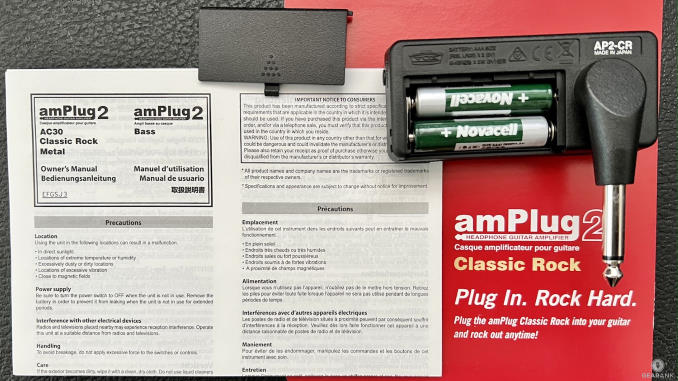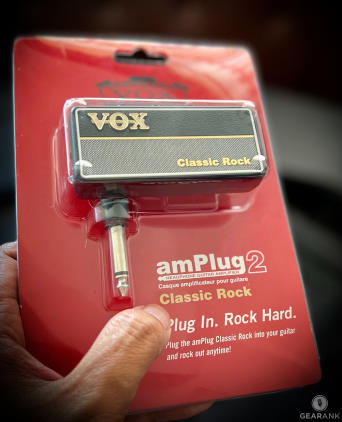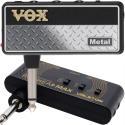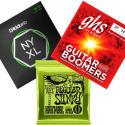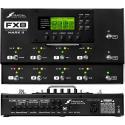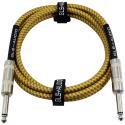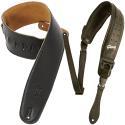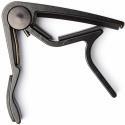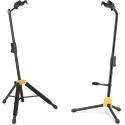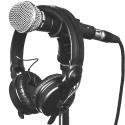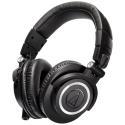Vox amPlug 2 Classic Rock AP2-CR Review - Guitar Headphone Amplifier
Street Price:
Manufacturer:
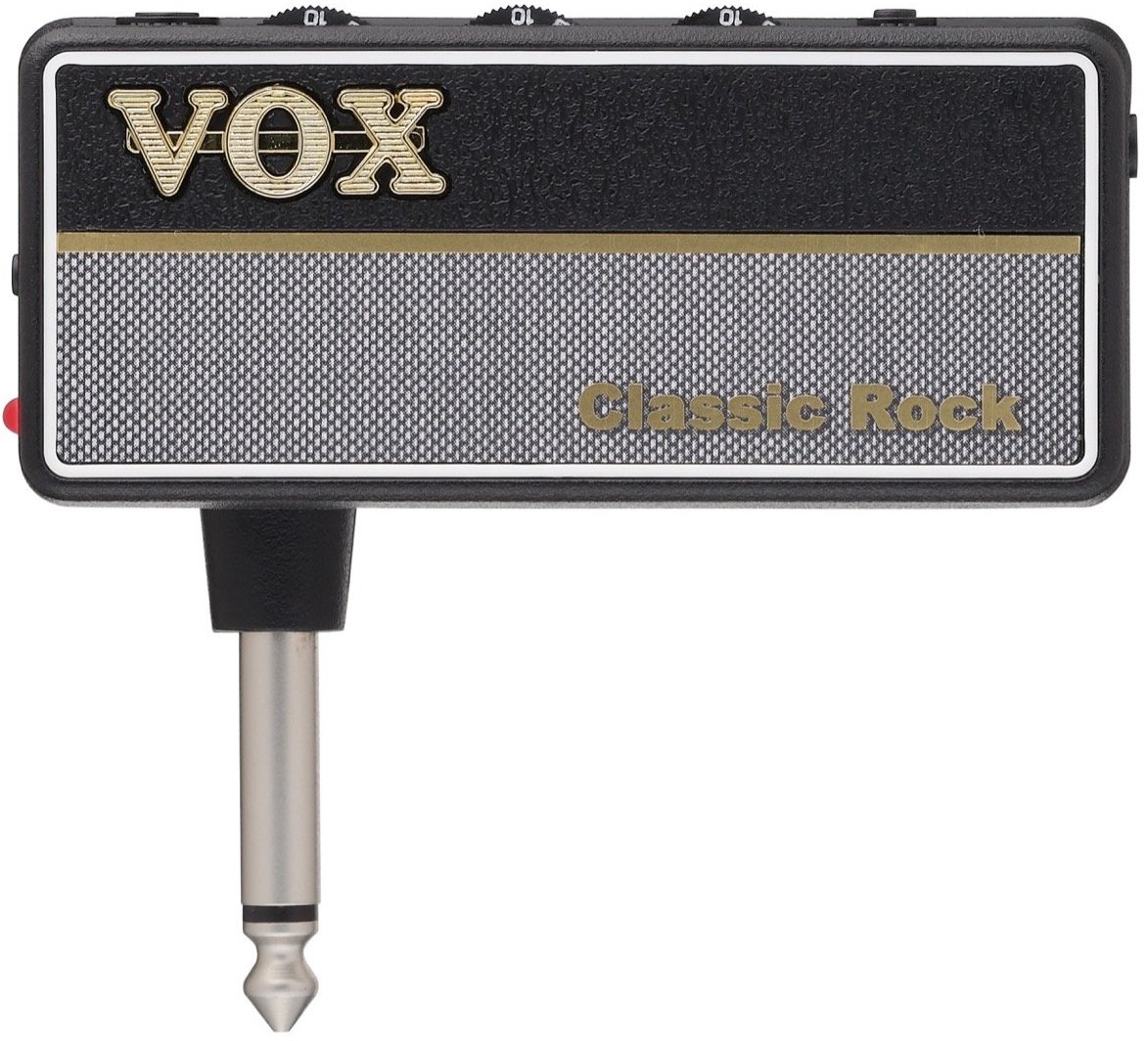
Gearank Recommended
See our Current Recommendation
Specifications
- Tone: Classic Rock
- Effects: 3 x Chorus, 3 x Delay, 3 x Reverb
- Controls: Knobs: Gain, Tone, Volume | Button: FX, Power/Mid-Boost Mode
- Inputs: 1 x 1/4", 1 x 1/8" (Aux in)
- Headphones: 1 x 1/8"
- Power Source: 2 x AAA Batteries (Up to 17 hours)
Support Links
- Product Manual
- Warranty - (1 Year)
- Vox Support
Vox amPlug 2 Classic Rock Review
There's simply no replacing the feel and sound of actual speakers, but loud playing can sometimes get us in trouble with our loved ones and neighbors.
Thankfully, most amps and effects processors have headphones out, allowing me practice and play as much as I like without causing much disturbance.
I usually pair my headphones with my guitar processors, but recently, I've been hooked to the convenience and good tone of the Vox amPlug 2 Classic Rock (AP2-CR). So far, I am loving how it sounds through closed-back headphones, and more importantly I find myself playing electric guitar more because of how easy it is to use and carry around.
Here I'll share in detail my experience with the unit, along with some tips on how to make better use of its features.
Amp Tone
At the core of classic rock tones are old overdriven tube amps that are often times cranked hard. In my experience, even big amps and guitar processors have a hard time emulating this sound, so I wasn't expecting much from something this small.
Thankfully, my low expectations were quickly exceeded - the AP2-CR did a nice job of emulating the midrange emphasis and crunchy overdrive flavor that are commonly associated with classic rock tunes. I especially love the "bite" when digging into the strings, which makes this a fun amp to use for practicing solos and improvisation. More importantly, I'm pleased that there's enough transparency with its overdrive that I can still sound like "myself".
Surprisingly, notes seem to decay organically like tube amps, and this is a big plus for me. Chords also sound surprisingly detailed and full, but only in low to mid gain levels.
Speaking of gain levels, driving it up too much results in muddy sounding chords and fizzy single note lines. This is unfortunate but understandable, given the price and target market of this unit. The muddy tone is especially noticeable when using single-coil pickups, but thankfully, it's not as muddy when I switch from Strat to Les Paul.
What sets this one apart from other amPlugs is its switchable (color coded) "Mid-Boost" Mode. It lets you choose between Mid-boost Off (Green), Mid-boost 1 Lo (Orange), Mid-boost 2 Hi (Red). This feature adds a virtual switchable booster circuit into the unit, emulating the commonly used boost pedal + amp setup of many rock guitarists.
While this amp is not meant for providing clean tone, I can get good clean tones by turning the gain knob all the way down in Green mode (Mid-boost Off). But I prefer the slightly dirty and gritty cleans that the Orange and Red modes provide. This mid boost works really well with my Strat, letting me hear the nuances of my playing better.
Review Setup and Tips
The headphones I used in this review are a closed-back Razer Kraken X, which to me is a good all-around, detailed sounding pair of cans. It sounded so good to me that there are times when I had to free up my ears to check if I am listening through the cans or through an actual amp.
Note that your experience may differ depending on the headphones you use. You'll probably get better results if you use headphones that are dedicated to music. I don't recommend using small earphones because the resulting tone will most likely lack bass response.
To check how it sounds through actual speakers, I used a 1/8" cable to connect the Amplug to the aux input of my amp. And to make sure that the voicing is un-affected by the other amp, I plugged it into an acoustic amp, a Laney LA35C. I was surprised by how good it sounds through this configuration - fuller and livelier. But because the cable I was using was short and flimsy, I encountered cable related noise and disconnects. It also limited my movement which at times caused me to accidentally unplug the cable. Good thing the amPlug attaches securely to my guitars, so it didn't fall off.
I recommend getting a good quality 1/8" cable with enough length for you to move around. And note that you'll need two of these cables if you want to plug to an amp and jam with tracks.
Effects
Vox equipped this unit with chorus, delay and reverb effects that you can cycle through via a single button. By themselves, the built-in effects are nothing to write home about, but they work well with the amp sound.
Since there are no knobs for tweaking effects parameters, I thought it was stuck to just high levels of chorus, reverb and delay. Thankfully, there are variations for each effect, which can be accessed by pressing the power button while holding down the FX button. And with it, I was able to get the more subtle versions of the effects, which I prefer. I personally use a bit of reverb to add space to the sound, and I often switch to delay when I am practicing solos.
Controls
Given its compact form factor, there's not much room for deep tweaking, but it does provide essential controls that include Gain, Tone and Volume. The controls seem to work fine for me, no big jumps or dips as I change the settings. The tone knob in particular responds really well, and is very useful for reducing excess highs. As mentioned above, I didn't like the tone when gain is raised too high. So what I do is raise the gain slowly to a point where I get enough overdrive with good transparency.
While I appreciate its lightweight and compact design, the cramped interface sometimes makes me inadvertently mess with the settings. I find this annoying, because at times I had to redo my tweaks again just to get back the tone I was happy with. Accidentally maxing out the volume knob can also be dangerous - both to your headphones or speakers and to your ears. Note that this unit can get really loud, so I recommend turning down the volume levels before putting on your headphones.
Build Quality
While it is light and made mostly of plastic material, it does feel well built. But even still, I recommend handling this unit with care, because it feels like it is not meant to survive bad falls and other hard beatings.
Thankfully, the plug and swivel mechanism feel solid, it attaches securely to both my Fender Strat and Les Paul without a hitch. Note that the swivel mechanism is limited to 5 notched positions, but in my experience these are enough to get the unit attached securely on my guitars.
What it lacks in durability it makes up for with its aesthetics. The front fascia with its old-school mini-amp like cosmetics make it really nice to look at, and after looking at it in detail for a while, I have yet to see any imperfection.
Package and Content
The unit comes encased in a plastic shell with red cardboard background. It comes with Vox AmPlug 2 labels and "Classic Rock" written on the front and back. Make sure to check for the model that you want, because there are many different amPlug 2 models available.
I forgot to buy batteries when I initially got the unit, so I thought I'd have to wait till I get some before using it. But I was happy to find that included in the package are two AAA batteries, making it usable right out of the box. As a precaution, I have since gotten extra batteries for when I need to swap them out. Thankfully, AAA batteries are easy to come by.
Vox also included a printed copy of the owner's manual, tucked inside the red cardboard background. It would've been nice if Vox included a good 1/8" jack cable, to utilize the unit's aux input function right at the get go.
Overall
All in all, I am satisfied with the performance of the Vox AP2-CR, and I find its tone to be true to its Classic Rock label. This is a must have for those who want a convenient practice amp for rock and similar types of music.



